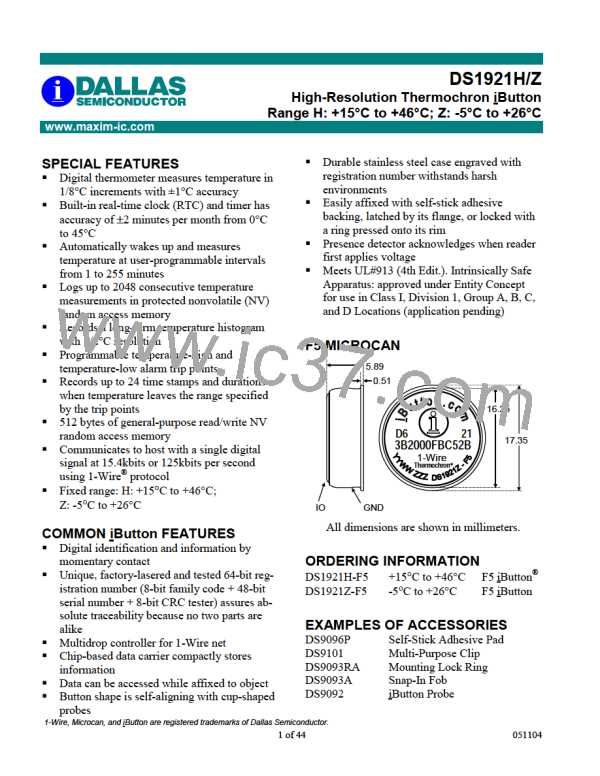DS1921H/Z
iButton DESCRIPTION
The DS1921H/Z Thermochron™ iButtons are rugged, self-sufficient systems that measure temperature
and record the result in a protected memory section. The recording is done at a user-defined rate, both as
a direct storage of temperature values as well as in the form of a histogram. Up to 2048 temperature
values taken at equidistant intervals ranging from 1 to 255 minutes can be stored. The histogram provides
64 data bins with a resolution of 0.5°C. If the temperature leaves a user-programmable range, the
DS1921H/Z will also record when this happened, for how long the temperature stayed outside the
permitted range, and if the temperature was too high or too low. Additional 512 bytes of read/write NV
memory allow storing information pertaining to the object to which the DS1921H/Z is associated. Data is
transferred serially via the 1-Wire protocol, which requires only a single data lead and a ground return.
Every DS1921H/Z is factory-lasered with a guaranteed unique electrically readable 64-bit registration
number that allows for absolute traceability. The durable stainless steel package is highly resistant to
environmental hazards such as dirt, moisture, and shock. Accessories permit the DS1921H/Z to be
mounted on almost any object, including containers, pallets, and bags.
APPLICATION
The DS1921Z is an ideal device to monitor the temperature of any object it is attached to or shipped with,
such as fresh produce, medical drugs and supplies. It is also ideal for use in refrigerators. The DS1921H
is intended for monitoring the body temperature of humans and animals and for monitoring temperature
critical processes such as curing, powder coating, and painting. Alternatively, the DS1921H can be used
for monitoring the temperature of clean rooms, and computer and equipment rooms. It can also aid in
calculating the proportional share of heating cost of each party in buildings with central heating. The
DS1921H has a fixed range of +15°C to +46°C. The DS1921Z has a fixed range of -5°C to +26°C. The
high resolution makes the DS1921H and DS1921Z suitable for scientific research and development. The
read/write NV memory can store information such as shipping manifests, dates of manufacture, or other
relevant data written as ASCII or encrypted files.
OVERVIEW
The block diagram in Figure 1 shows the relationships between the major control and memory sections of
the DS1921H/Z. The device has seven main data components: 1) 64-bit lasered ROM; 2) 256-bit scratch-
pad; 3) 4096-bit general-purpose SRAM; 4) 256-bit register page of timekeeping, control, and counter
registers; 5) 96 bytes of alarm time stamp and duration logging memory; 6) 128 bytes of histogram mem-
ory; and 7) 2048 bytes of data-logging memory. Except for the ROM and the scratchpad, all other mem-
ory is arranged in a single linear address space. All memory reserved for logging purposes, counter reg-
isters and several other registers are read-only for the user. The timekeeping and control registers are
write-protected while the device is programmed for a mission.
The hierarchical structure of the 1-Wire protocol is shown in Figure 2. The bus master must first provide
one of the seven ROM function commands: 1) Read ROM; 2) Match ROM; 3) Search ROM; 4) Condi-
tional Search ROM; 5) Skip ROM; 6) Overdrive-Skip ROM; or 7) Overdrive-Match ROM. Upon
completion of an Overdrive ROM command byte executed at standard speed, the device will enter
Overdrive mode, where all subsequent communication occurs at a higher speed. The protocol required for
these ROM function commands is described in Figure 13. After a ROM function command is
successfully executed, the memory functions become accessible and the master may provide any one of
the seven available commands. The protocol for these memory function commands is described in Figure
10. All data is read and written least significant bit first.
Thermochron is a trademark of Dallas Semiconductor.

 DALLAS [ DALLAS SEMICONDUCTOR ]
DALLAS [ DALLAS SEMICONDUCTOR ]